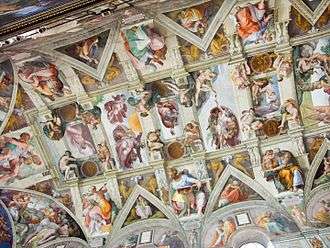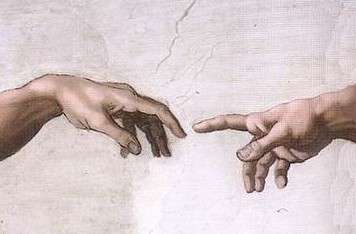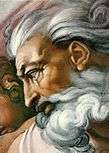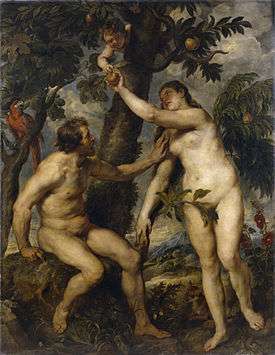The Creation of Adam
| The Creation of Adam | |
|---|---|
| Italian: Creazione di Adamo | |
.jpg) | |
| Artist | Michelangelo |
| Year | c. 1512 |
| Type | Fresco |
| Dimensions | 280 cm × 570 cm (9 ft 2 in × 18 ft 8 in)[1] |
The Creation of Adam (Italian: Creazione di Adamo) is a fresco painting by Michelangelo, which forms part of the Sistine Chapel's ceiling, painted c. 1508–1512. It illustrates the Biblical creation narrative from the Book of Genesis in which God gives life to Adam, the first man. The fresco is part of a complex iconographic scheme and is chronologically the fourth in the series of panels depicting episodes from Genesis.
The image of the near-touching hands of God and Adam has become iconic of humanity. The painting has been reproduced in countless imitations and parodies.[2][3] Michelangelo's Creation of Adam is one of the most replicated religious paintings of all time.[4]
History

In 1505, Michelangelo was invited back to Rome by the newly elected Pope Julius II. He was commissioned to build the Pope's tomb, which was to include forty statues and be finished in five years.
Under the patronage of the Pope, Michelangelo experienced constant interruptions to his work on the tomb in order to accomplish numerous other tasks. Although Michelangelo worked on the tomb for 40 years, it was never finished to his satisfaction.[5] It is located in the Church of S. Pietro in Vincoli in Rome and is most famous for his central figure of Moses, completed in 1516.[6] Of the other statues intended for the tomb, two known as the Rebellious Slave and the Dying Slave, are now in the Louvre.[5]
During the same period, Michelangelo painted the ceiling of the Sistine Chapel, which took approximately four years to complete (1508–1512).[6] According to Condivi's account, Bramante, who was working on the building of St Peter's Basilica, resented Michelangelo's commission for the Pope's tomb and convinced the Pope to commission him in a medium with which he was unfamiliar, in order that he might fail at the task.[7]
Michelangelo was originally commissioned to paint the Twelve Apostles on the triangular pendentives that supported the ceiling, and cover the central part of the ceiling with ornament.[8] Michelangelo persuaded Pope Julius to give him a free hand and proposed a different and more complex scheme, representing the Creation, the Fall of Man, the Promise of Salvation through the prophets, and the genealogy of Christ. The work is part of a larger scheme of decoration within the chapel which represents much of the doctrine of the Catholic Church.[8]
The composition stretches over 500 square metres of ceiling,[9] and contains over 300 figures.[8] At its centre are nine episodes from the Book of Genesis, divided into three groups: God's Creation of the Earth; God's Creation of Humankind and their fall from God's grace; and lastly, the state of Humanity as represented by Noah and his family. On the pendentives supporting the ceiling are painted twelve men and women who prophesied the coming of Jesus; seven prophets of Israel and five Sibyls, prophetic women of the Classical world.[8] Among the most famous paintings on the ceiling are The Creation of Adam, Adam and Eve in the Garden of Eden, the Deluge, the Prophet Jeremiah and the Cumaean Sibyl.
Composition

God is depicted as an elderly white-bearded man wrapped in a swirling cloak while Adam, on the lower left, is completely nude. God's right arm is outstretched to impart the spark of life from his own finger into that of Adam, whose left arm is extended in a pose mirroring God's, a reminder that man is created in the image and likeness of God (Gen. 1:26). Another point is that Adam's finger and God's finger are not touching. It gives the impression that God, the giver of life, is reaching out to Adam who has yet to receive it; they are not on "the same level" as would be two humans shaking hands, for instance.
Many hypotheses have been formulated regarding the identity and meaning of the twelve figures around God. The person protected by God's left arm might be Eve due to the figure's feminine appearance and gaze towards Adam, but was also suggested to be Virgin Mary, Sophia goddess of wisdom, the personified human soul, or an angel of feminine build.[10]
The Creation of Adam is generally thought to depict the excerpt "God created man in His own image, in the image of God He created him" (Gen. 1:27). The inspiration for Michelangelo's treatment of the subject may come from a medieval hymn, "Veni Creator Spiritus", which asks the 'finger of the paternal right hand' (digitus paternae dexterae) to give the faithful speech.[11]
Sources
Michelangelo's main source of inspiration for his Adam in his Creation of Adam may have been a cameo showing a nude Augustus Caesar riding sidesaddle on a Capricorn.[12] This cameo is now at Alnwick Castle, Northumberland.[13] The cameo used to belong to cardinal Domenico Grimani who lived in Rome while Michelangelo painted the ceiling. Evidence suggests that Michelangelo and Grimani were friends. This cameo offers an alternative theory for those scholars who have been dissatisfied with the theory that Michelangelo was mainly inspired by Lorenzo Ghiberti's Adam in his Creation of Adam.[14]



Analysis
Several hypotheses have been put forward about the meaning of The Creation of Adam's highly original composition, many of them taking Michelangelo's well-documented expertise in human anatomy as their starting point.
Portrayal of the human brain
In 1990, an Anderson, Indiana physician Frank Meshberger noted in the Journal of the American Medical Association that the background figures and shapes portrayed behind the figure of God appeared to be an anatomically accurate picture of the human brain.[15] On close examination, borders in the painting correlate with major sulci of the cerebrum in the inner and outer surface of the brain, the brain stem, the frontal lobe, the basilar artery, the pituitary gland and the optic chiasm.[15][16]
Portrayal of the birth process
Alternatively, it has been observed that the red cloth around God has the shape of a human uterus (one art historian has called it a "uterine mantle"[17]) and that the scarf hanging out, coloured green, could be a newly cut umbilical cord.[18] Recently a group of Italian researchers published on Mayo Clinic Proceedings an article where the images of the mantle and the postpartum uterus were overlapped.[19] According to Enrico Bruschini (2004), "This is an interesting hypothesis that presents the Creation scene as an idealised representation of the physical birth of man ("The Creation"). It explains the navel that appears on Adam, which is at first perplexing because he was created, not born of a woman."[20]
References
- ↑ Gardner, Helen; Kleiner, Fred S. (2009). Gardner's Art Through the Ages. A Concise Global History (2nd ed.). Stamford, Connecticut: Cengage Learning. p. 265. ISBN 978-0-495-50346-0.
- ↑ Katz, Jamie (10 April 2009). "The Measure of Genius". Smithsonian.com. Retrieved 13 September 2013.
- ↑ Teixeira, Nuno. "Pop Culture Art Inspired By Michelangelo's The Creation Of Adam". bitrebels.com. Retrieved 13 September 2013.
- ↑ "20 of the World's Most Famous Art Pieces - History Lists". historylists.org. Retrieved 2018-07-23.
- 1 2 Goldscheider, pp. 14–16
- 1 2 Bartz and König, p. 134
- ↑ Coughlan, p. 112
- 1 2 3 4 Goldscheider, pp. 12–14
- ↑ Bartz and König, p. 43
- ↑ Steinberg, Leo (December 1992). "Who's who in Michelangelo's Creation of Adam: A Chronology of the Picture's Reluctant Self-Revelation". The Art Bulletin. 74 (4): 553–554. JSTOR 3045910.
- ↑ Veni, Creator Spiritus / Come Holy Spirit, Creator Blest. Preces-latinae.org.
- ↑ Cameo on Google Images.
- ↑ Sutherland, Bruce (Winter 2013). "Cameo Appearances on the Sistine Ceiling". Source: Notes in the History of Art. University of Chicago Press. 32 (2): 14. JSTOR 23292907. Alnwick Castle is in Northumberland, not Northampton, as the captions state. The Duke of Northumberland who owns the cameos discussed in the article has expressed his appreciation in a letter to the author.
- ↑ Sutherland, Bruce (Winter 2013). pp. 12–18.
- 1 2 Meshberger, Frank Lynn (10 October 1990). "An Interpretation of Michelangelo's Creation of Adam Based on Neuroanatomy". JAMA. 264 (14): 1837–41. doi:10.1001/jama.1990.03450140059034. PMID 2205727. Retrieved 24 September 2012. Pdf. Excerpt on Mental Health & Illness.com. Retrieved 21 September 2010.
- ↑ Fields, R. Douglas (27 May 2010). "Michelangelo's secret message in the Sistine Chapel: A juxtaposition of God and the human brain". Scientific American. Retrieved 9 June 2016.
- ↑ Stokes, Adrian (1955). Michelangelo. A study in the nature of art. City University London: Tavistock Publications. p. 89.
- ↑ Bruschini, Enrico (2004). Masterpieces of the Vatican. Vatican City: Edizioni Musei Vaticani. ISBN 978-88-8117-088-3. p. 112.
- ↑ Di Bella, Stefano (2015). "The "Delivery" of Adam: A Medical Interpretation of Michelangelo". Mayo Clinic Proceedings. 90 (4): 505–508. doi:10.1016/j.mayocp.2015.02.007. PMID 25841253.
- ↑ Bruschini, Enrico (2004). p. 112.
External links

- Models of wax and clay used by Michelangelo in making his sculpture and paintings

